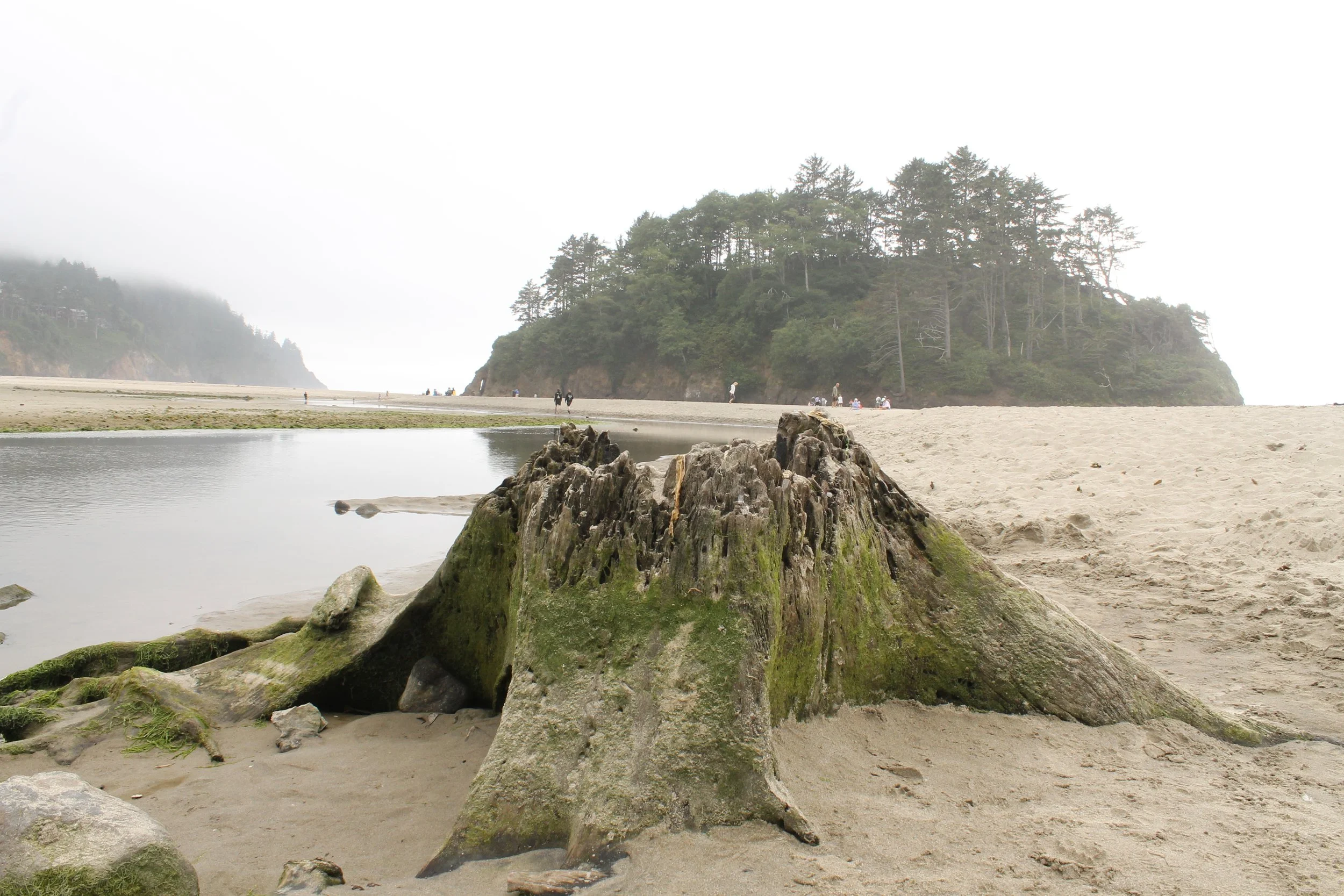The Mysterious Neskowin Ghost Forest
Ghost forest in front of Proposal Rock
When the tide recedes, ghosts emerge on the Oregon Coast. Ancient, barnacle-encrusted stumps appear above the waves, relics of a prehistoric forest buried long ago by encroaching sand. One of the most impressive and accessible ghost forests on the Oregon Coast is at Neskowin Beach, where dozens of 2,000-year-old Sitka spruce stumps can be seen year-round at low tide. Unlike many Oregon beaches, Neskowin rarely gets crowded and its seclusion adds to the otherworldly atmosphere of the ghost forest. Here is everything you need to know when visiting this hidden gem of the Oregon Coast.
Keyhole opening at Proposal Rock
Know before you go
To see the ghost forest, you’ll want to plan your visit around low tide. The lower the tide, the more impressive it will be.
The weather on the Oregon Coast can be dramatically different than the rest of the state. On my last visit, I left 90-degree, sunny Portland and arrived at the cold and foggy coast needing a coat.
Neskowin Beach is a great destination for families. Neskowin Creek has good potential for wading and the rocky formations on the beach offer plenty to explore.
Go ahead and bring your dog! Neskowin Beach State Recreation Site is dog-friendly.
Sea cave at Neskowin Beach
About Neskowin Beach
Neskowin has three miles of picturesque coastline. At its northern end, the Nestucca River empties into the Pacific Ocean. At its center, look for the dome of Proposal Rock with its intriguing keyhole-shaped opening that is impossible (for me anyway) not to climb through. The cliffs of Cascade Head rise on the southern end of the beach. You can find an interesting sea cave there.
The Neskowin Creek flows out into the Pacific at this beach. Be prepared to wade across the creek to reach the ghost forest. It was about knee height during my last visit.
The town of Neskowin is set pretty far back from the beach, so you feel surrounded by nature when you’re near the water. Bring everything you want from the car when you head to the beach. It is a bit of a trek across the sand to get back to the parking lot.
Small tidepool in a stump of the ghost forest
Emergence of the Ghost Forest
The Neskowin ghost forest was not always as visible as it is today. Just a few decades ago, it was hidden under layers of sand. The stumps appeared following some intense winter storms in the late 1990s that eroded this overlying sand and allowed for the re-emergence of the ghost forest. Since the exposure of the forest, waves carved away the ancient forest soils, leaving the stumps behind.
The stumps of the ghost forest today are hardly barren. Barnacles have colonized them so completely that it is hard to see any wood from the original trees. In some cases, tiny tidepools with anemones have even formed in the stumps.
Stumps of the Neskowin ghost forest
Formation of the Ghost Forest
I did a deep dive on the formation of the Neskowin ghost forest because there is a lot of confusion about it online. Many sites will tell you that an earthquake and subsequent tsunami hit the Oregon Coast, killing and burying the forest at Neskowin.
Here is the confusion. While there is good evidence that giant earthquakes and tsunamis do happen every few hundred years in the Pacific Northwest and have created ghost forests, this is not what geologists think happened at Neskowin Beach.
So what did cause it? The short answer is changing sea levels and the movement of sand over time.
An Oregon Coast Beach Connection article does a great job explaining the history of the misunderstanding surrounding the Neskowin ghost forest. This article discusses the work of geologists Roger Hart and Curt Peterson, who are authorities on coastal ghost forests, and includes an interview with Peterson. I managed to get a copy of Hart and Peterson’s 2007 research article on ghost forests like Neskowin with the help of an interlibrary loan. Unfortunately, there is no free full-text version online, which I’m sure has contributed to the confusion on the topic. Hart and Peterson address the Neskowin ghost forest specifically and present a complete model for its formation. Sure enough, no earthquake or tsunami was involved.
Here is a summary of Hart and Peterson’s model explaining the formation of the Neskowin ghost forest:
1) Waves eroded the shore during a time of rising sea level, creating a platform.
2) A forest formed on this platform and the adjacent sea cliffs when the sea level receded.
3) Sand accumulated in this forest, gradually burying it.
4) The encroaching sand preserved the forest and its soils.
5) Erosion removed the sand, exposing the remains of the ghost forest.
In other words, the ghost forest we see today at Neskowin is a product of thousands of years of natural processes rather than a single cataclysmic event. Nor have the changes stopped. Waves continue to erode the sand around the ghost forest stumps, which sometimes become uprooted and disappear from the forest.
Neskowin Creek on its way to the Pacific Ocean
Tide Tables
To see the Neskowin ghost forest, it is important to visit around low tide. Tide tables like this one help predict when to expect high and low tides each day. There isn’t a standard level for tides, so low tide can mean a range of water levels. The lower the number on the tide table (which extends into negative numbers), the lower the tide.
As long as you are visiting at low tide, there is a good chance you will be able to see the ghost forest. If you visit at a particularly low tide, more stumps will be visible and they will be easier to approach. Keep in mind that tide tables are predictions, similar to weather forecasts.
Giant fish marks the entrance to the public parking lot at Neskowin
Parking at Neskowin
Neskowin has a public parking lot directly off Highway 101. It is free to park there and no pass or permit is needed. Look for the large painted wooden fish. Make sure to park in this lot instead of the nearby hotel parking lots unless you are staying at one of the hotels.
There are public restrooms by the parking lot. There are also a couple of picnic tables, although they are not in a very scenic place and I would suggest taking a picnic to the beach instead.
To reach the ocean, follow the sign in the parking lot to the sandy trail across the road. You will pass the Hawk Creek Café and Proposal Rock Inn on the way to the beach. Head toward Proposal Rock to reach the ghost forest.
The Hawk Creek Café on the way to Neskowin Beach
Where to Eat in Neskowin
Neskowin is a small community with only a few businesses. The Hawk Creek Café normally offers sit-down dining, although they are only doing takeout at the time of writing this article. Their menu has options like pasta, burgers, and wood-fired pizzas.
Across the street, the Neskowin Trading Post has good takeaway food and drink options, including a bakery and deli. There are a few bistro tables on the patio or you can take your food down to the beach for a picnic.
For more dining options, head 15 minutes north on Highway 101 to reach Pacific City. Pelican Brewing Company offers great views of the ocean from its brewpub there.
Path to Neskowin Beach past Proposal Rock Inn
Where to Stay in Neskowin
There are a couple of places you can stay right in Neskowin: Proposal Rock Inn and Neskowin Resort. They are right next to each other and both are close to the ocean. Amenities vary with some rooms offering ocean views, multiple bedrooms, and kitchenettes. They are options for dog-friendly lodging, too.
Patch of exposed wood on a ghost forest stump
Getting There
Neskowin is two hours away from Portland. Take Highway 99 West to OR-18 West, then turn onto Highway 101 North to reach the public parking lot at Neskowin.
From Salem, take OR-22 West to OR-18 West. Then, turn onto Highway 101 North to reach Neskowin. The drive will take about an hour.
Enjoy the ghost forest!
With love,
Emma
Reference:
Hart, R., & Peterson, C. (2007). Late‐Holocene buried forests on the Oregon Coast. Earth Surface Processes and Landforms, 32 (2), 210-229.
Looking for more to do at the Coast? From north to south, here are trip suggestions and travel tips for:
Also, check out my guides to the wildlife of the Oregon Coast and Oregon geology.











